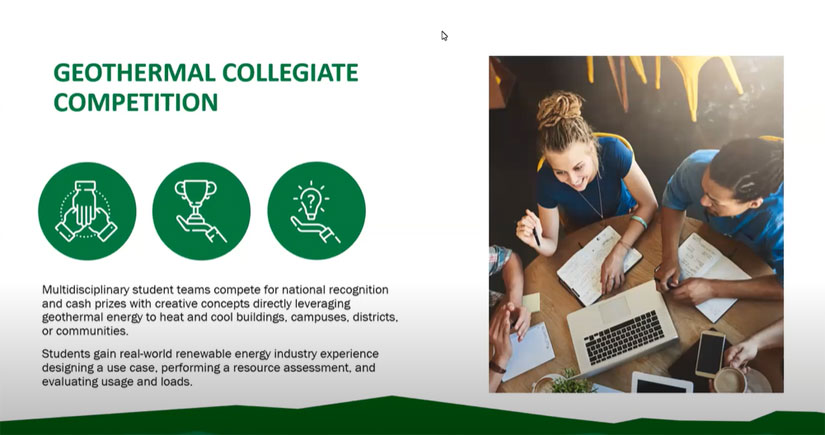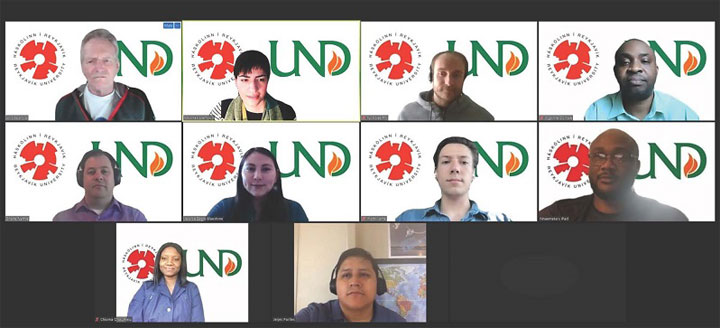In Geothermal Collegiate Competition, Students Compete Using Heat Beneath Our Feet
Multidisciplinary Teams Devise Direct-Use Geothermal Systems and Community Engagement Strategies for Native American Reservations, Universities, Mixed-Use Communities, and Hospital Campuses

The National Renewable Energy Laboratory (NREL), Acting Assistant Secretary for the Department of Energy (DOE) Office of Energy Efficiency and Renewable Energy (EERE) Kelly Speakes-Backman, and leadership from DOE's Geothermal Technologies Office have announced the winners of the Spring 2021 Geothermal Collegiate Competition.
Watch a recording of the live winner announcement.
The competition engages students from across the United States to design direct-use concepts that leverage geothermal energy to heat and cool buildings, campuses, districts, or entire communities. Participating students hone project development, design, and communications skills while contributing to greater public understanding of geothermal power as a direct, renewable source of energy. Team submissions included a use case, resource assessment, usage evaluation, and a plan to engage the local community.
America's Next Renewable Powerhouse
Susan Hamm, director of the Geothermal Technologies Office, helped kick off the award announcement, describing geothermal energy as "America's next renewable powerhouse." Hamm emphasized the importance of the Geothermal Collegiate Competition as part of the Biden-Harris administration's commitment to "helping the geothermal community reach its targets and establish geothermal as a prominent piece of America's renewable energy mix."
Speakes-Backman echoed this sentiment before announcing the winners. "Competitions like these are so important because it's today's participants who are going to represent the future clean energy workforce," she said. "You all can play a crucial role in addressing the climate crisis and securing our clean energy future."
University of North Dakota Team Designs Geothermal Greenhouse on Native American Reservation
The University of North Dakota (UND) Geothermal Team, including students from both UND and Reykjavik University, won first place for their prospectus on gas well recompletion for geothermal district energy in Mandaree, North Dakota. Mandaree is located on the Fort Berthold Indian Reservation as part of the Mandan, Hidatsa, and Arikara Nation. Mandaree's closest grocery store is about 30 minutes away, there are few opportunities for local employment, and the cost of energy is high.
The UND team project would use existing oil and gas wells to generate heat, food, and jobs through integration of a direct-heated greenhouse. The geothermal greenhouses could produce 570,000 pounds of produce annually, offering the potential to offset nearly 2,800 metric tons of carbon dioxide each year, as compared to a gas-heated greenhouse.

Members of the winning team include Moones Alamooti, Jessica Eagle-Bluestone, Nicholas Fry, Shane Namie, Nnaemeka Ngobidi, Ogonna Obinwa, Chioma Onwumelu, and Jerjes Porlles from University of North Dakota, as well as Matthew Villante from Reykjavik University.
Team Captain Nicholas Fry said, "This study was one of the most rewarding experiences of my academic endeavors. We brought together a bit of geothermal experience and many industry-accomplished students from the oil and gas sector. This convergence of ideas is exactly what is necessary to reach beyond petroleum. With only a small nudge, North Dakota can transfer existing oil and gas workforce skills towards the exploitation of geothermal energy. With an existing labor force full of roughnecks, pipefitters, engineers, and scientists, the Williston area can be America's geothermal baseload powerhouse. We made one more step in that direction."
Second place was awarded to the Sooners Geothermal team from University of Oklahoma, who identified hydrocarbon wells that can be converted to geothermal wells for heating and cooling in the local community.
Third place went to the Big Red Heat team from Cornell University, who aimed to achieve carbon-neutral district heating on Cornell's Ithaca campus using ambitious deep, direct use of geothermal energy.
Honorable mention for geosciences was awarded to a team from Colorado School of Mines, while a team with students from University of California–Berkeley and Rutgers University earned honorable mention for stakeholder engagement.
Ready for the Challenge? 2021–2022 Competition Offers Up to $10,000 Cash Prizes, Live Events
The next round of the Geothermal Collegiate Competition is gearing up now. In the new, year-long 2021‒2022 competition, students will assume the role of a geothermal developer leveraging a geothermal application to heat and cool buildings, campuses, and districts. Teams are highly encouraged to select sites that would benefit disadvantaged communities and underrepresented groups. Participation is free and offers students the chance to win national recognition, earn cash prizes of up to $10,000, and gain real-world renewable energy industry experience. Each team will present its project in a video, and winners will celebrate with their universities at on-site events next spring.
Do you think you know the future winning team? Join the upcoming year-long Geothermal Collegiate Competition Class of 2022, set to kick off during fall 2021.
This article has been updated to reflect an editorial change made after its original publication.
Last Updated May 28, 2025
